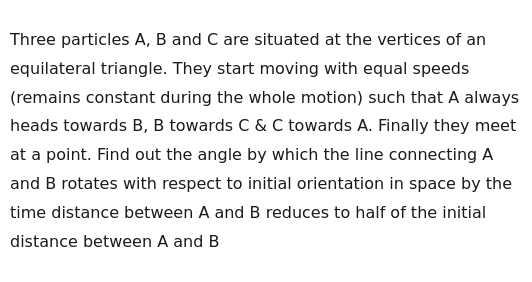Question
Question: Three particles A, B and C are situated at the vertices of an equilateral triangle. They start movin...
Three particles A, B and C are situated at the vertices of an equilateral triangle. They start moving with equal speeds (remains constant during the whole motion) such that A always heads towards B, B towards C & C towards A. Finally they meet at a point. Find out the angle by which the line connecting A and B rotates with respect to initial orientation in space by the time distance between A and B reduces to half of the initial distance between A and B

\frac{\sqrt{3}}{3} \ln 2
Solution
Let the initial distance between the particles A, B, and C be L0. They form an equilateral triangle. Let the speed of each particle be v. Particle A moves towards B, B towards C, and C towards A. Due to symmetry, the particles always form an equilateral triangle, and the centroid of the triangle remains stationary. The distance between any two particles decreases at a constant rate.
Consider the relative velocity of particle A with respect to particle B, vA/B=vA−vB. Let L(t) be the distance between A and B at time t. The rate of change of this distance is the component of vA/B along the line AB. Let r^AB be the unit vector from A to B. The velocity of A is vA=vr^AB. The velocity of B is vB, which is directed towards C. The angle between vA (along AB) and vB (along BC) is 120∘. Thus, the angle between r^AB and vB is 120∘. The rate of change of the distance L is dL/dt=dtd∣B−A∣. This is the component of vB/A=vB−vA along r^AB. dL/dt=(vB−vA)⋅r^AB=vB⋅r^AB−vA⋅r^AB. vA⋅r^AB=vr^AB⋅r^AB=v. vB⋅r^AB=vcos(120∘)=−v/2. So, dL/dt=−v/2−v=−3v/2. The distance between A and B decreases linearly with time.
Now consider the rotation of the line AB. The rotation is caused by the component of the relative velocity vB/A=vB−vA perpendicular to the line AB. The component of vA perpendicular to AB is 0. The component of vB perpendicular to AB is vsin(120∘)=v3/2. This component is directed such that it causes the line AB to rotate. The angular velocity ω of the line AB is given by the perpendicular component of vB/A divided by the distance L. The perpendicular component of vB/A is (vB)⊥−(vA)⊥=v3/2−0=v3/2. The angular velocity is ω=Lv3/2. This angular velocity is positive, indicating a counter-clockwise rotation (if we assume the standard orientation of the triangle and the direction of motion).
We want to find the total angle of rotation Δϕ when the distance L reduces from L0 to L0/2. The angular velocity is ω=dϕ/dt=2Lv3. We know dL/dt=−3v/2, so dt=−3v2dL. Substitute dt into the equation for dϕ: dϕ=ωdt=2Lv3(−3v2dL)=−3L3dL.
To find the total angle of rotation, integrate dϕ as L goes from L0 to L0/2: Δϕ=∫L0L0/2−3L3dL=−33[ln∣L∣]L0L0/2 Δϕ=−33(ln(L0/2)−ln(L0))=−33ln(L0L0/2)=−33ln(1/2) Δϕ=−33(−ln2)=33ln2.
The angle by which the line connecting A and B rotates is 33ln2 radians.
